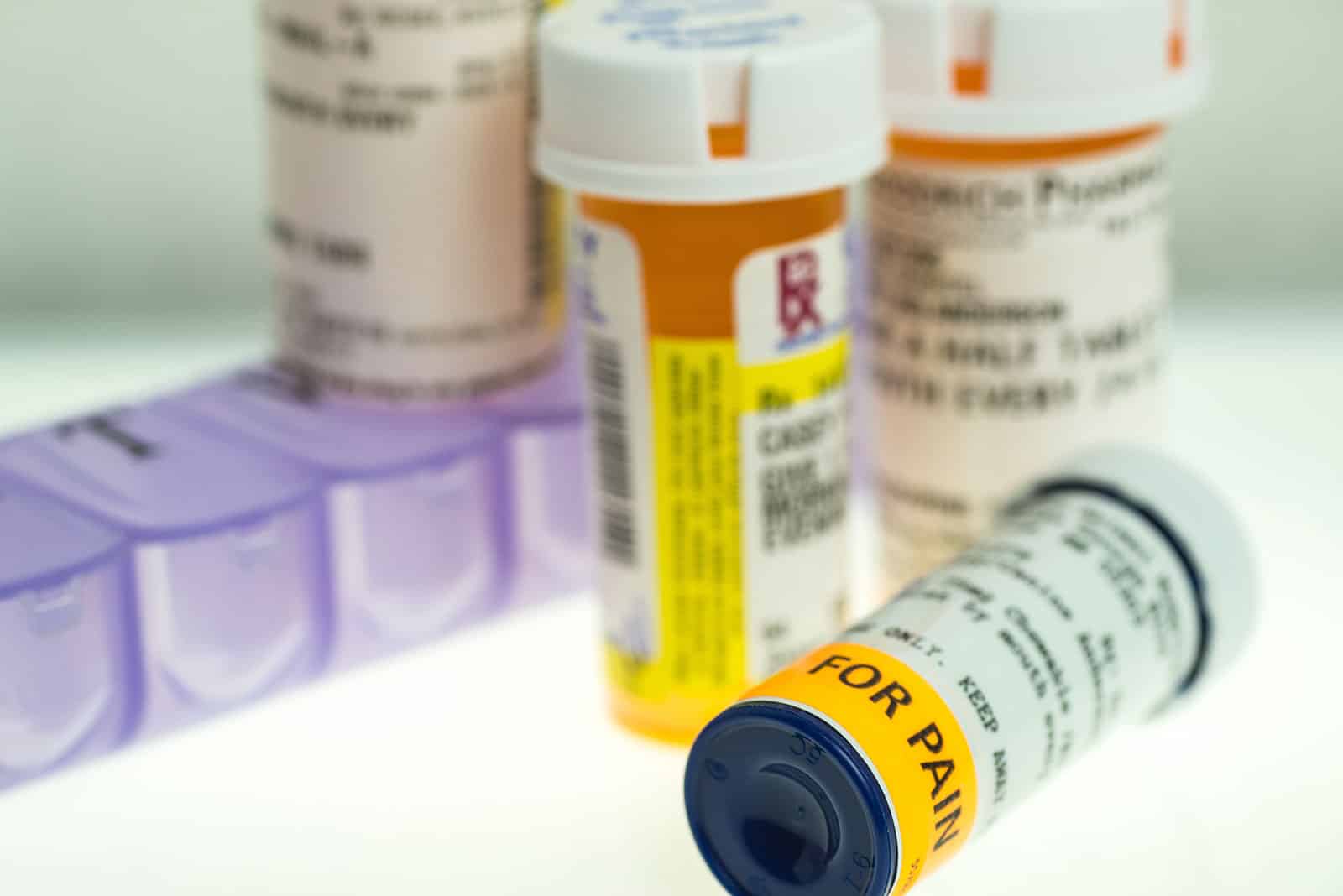Percocet is a combination narcotic prescription medication that contains the non-opioid acetaminophen and the opioid oxycodone. The acetaminophen component reduces fever and works to complement the effects of oxycodone, an opioid that changes how the body experiences and responds to pain. At recommended doses, Percocet is effective in treating moderate to severe pain, but it also carries a risk of dependency. Due to its potential for misuse, Percocet is only administered when non-opioid pain relievers have proven to be inadequate or ineffective.
What Is Pink Perc 10?
Percocet tablets are manufactured in four different dosage levels that contain between 2.5 mg and 10 mg of oxycodone. One of these varieties, a pink pill with a K56 imprint known to some as “Pink Perc 10,” is an immediate-release medication that achieves maximum potency about 30 minutes to an hour after it is swallowed and remains effective for up to six hours.
Oxycodone is a mu-agonist opioid analgesic, similar to morphine, that can be used to manage acute, severe pain. Pink Percocet generally contains 325 mg of acetaminophen and is also marked “10mg” to indicate its dosage strength of 10 milligrams of oxycodone. It is primarily prescribed for short-term use and can alternatively be colored blue, green, or white. The drug is a Schedule II-controlled substance that should only be used as prescribed by a licensed healthcare practitioner. Some intended medical uses of Pink Perc 10 include treating pain after major surgery, accidents, injuries, and traumatic events.
Risks and Side Effects
Because of the way oxycodone affects the brain’s pain receptors, it can easily become physically and psychologically addictive if it’s used improperly. It also has the potential to cause liver damage. Percocet is known to have side effects even when taken as prescribed, which can include everything from mild drowsiness and sedation to dizziness, disorientation, and lightheadedness. Like other opioids, it can also induce euphoria along with unpleasant physical reactions like constipation, nausea, vomiting, itching, and rash.
When Percocet is mixed with other chemicals or drugs, it can become less effective and cause unwanted side effects. Patients who accidentally or purposely take oxycodone with allergy medication, drugs for stomach issues, or MAOIs can experience negative reactions. Mixing oxycodone with alcohol, sedatives, or other opioids can increase their levels in the blood or accelerate the drug’s release and cause sleepiness, tiredness, changes in breathing, and potentially lead to an overdose.
Using Percocet improperly can lead to addiction, overdose, and worse. The National Institute on Drug Abuse reports that prescription opioids were linked to over 17,000 deaths in 2017. Excessive consumption can result in death, so it’s important to recognize the signs of an overdose, which may include fatigue and lethargy, pinpoint pupils, cold and clammy skin, a weak pulse, and confusion.
Potential for Misuse and Addiction
Because Percocet can produce feelings of euphoria, patients sometimes intentionally take it in an altered physical form, combine it with alcohol or other drugs, or take more than the prescribed dose to enhance its effects. These activities increase the risk of addiction and overdose. Percocet pill misuse may include:
Crushing and Snorting Percocet
Crushing Percocet pills into a fine powder and then snorting it can rapidly deliver the drug into the bloodstream and intensify its effects.
Chewing Percocet
Chewing Percocet pills can cause the medication to enter the bloodstream more quickly and increase the risk of overdose.
Injecting Percocet
Dissolving Percocet, then injecting it directly into the bloodstream, produces an intense high very quickly.
People who are addicted to Percocet often develop strategies to ensure they have access to the drug, even when the risk of negative consequences is high. Addicts may engage in criminal activity, such as seeking out multiple prescriptions, exaggerating or misrepresenting symptoms to get a prescription, stealing medication, or purchasing it illegally.
The Addictive Potential of Pink Perc 10
In the United States, abuse of Percocet and other prescription opioids is common, with over 3.3 million people developing dependence every year. According to the Center for Disease Control (CDC), more than 47,000 people suffered opiate-related deaths in 2017, and 67.8% were attributed to overdoses from oxycodone-based prescription medications like Percocet and OxyContin.
Taking opioids like Percocet can easily cause physical as well as psychological dependence. The more potent and euphoria-inducing the drug, the more likely it is to be addictive. Percocet and other oxycodone-based medications are considered to have a higher addiction potential than hydrocodone-based drugs, methadone, morphine, fentanyl, and buprenorphine.
Using Percocet in higher doses, more frequently than prescribed, or for prolonged periods increases the risk of addiction, which may include drug cravings and uncontrolled and continuous use that has negative physical and social consequences. The body can develop a tolerance to Percocet, which means that as time passes, more of the drug is needed to achieve desirable effects. This tolerance, along with increased physiological and psychological dependency, can increase the risk of overdose, which can be characterized by depressed respiratory activity, excessive drowsiness, loss of consciousness, and death.
Legal and Regulatory Aspects of Percocet
Percocet tablets are a Schedule II-controlled substance that can be prescribed by authorized primary care clinicians. To help prevent the misuse of the drug, doctors should follow the CDC’s 2022 practice guidelines and consider the Opioid Analgesic Risk Evaluation and Mitigation Strategy (REMS) issued by the Food and Drug Administration (FDA) to assess each patient’s risk for addiction, abuse, and misuse before prescribing Percocet. They should prescribe opioids at the lowest effective dose for the patient’s presented symptoms and monitor all patients who take the drug.
Providers are strongly encouraged to follow precautionary measures, which include:
- undertaking and completing a REMS-compliant education program
- advising patients and caregivers on the safe use, risks, and proper storage and disposal of Percocet
- emphasizing the importance of following the medication guide and instructions the pharmacy provides
- considering using patient-prescriber agreements that encourage responsible use and community safety
The 2022 prevention guideline also promotes patient-centered and flexible approaches to prescribing opioids that include screening questions to identify patients who may be at high risk for substance use. It also encourages culturally informed communication to prevent discrimination during treatment for pain.
Addressing Misconceptions and Myths about Percocet
Because opioid medications can be addictive and are often associated with illicit and criminal use, they are often subject to personal biases that are not grounded in fact. Some of these myths and misconceptions are as follows:
Prescribed Opioids Are Low-Risk Medications
All opioids carry risks of dependency, addiction, and overdose. Your provider should minimize your risk of addiction by prescribing you the lowest effective dose of medication for the shortest amount of time necessary. Always take the medication as prescribed, do not take extra doses, and be very careful about mixing your medication with other substances.
Opioid Addicts Can Use Willpower to End Their Addictions
Opioids can alter a person’s brain chemistry and make it physically difficult for them to stop using the drug, despite negative physical and social consequences. Unmediated or sudden withdrawal can potentially cause severe physical side effects and increase the potential for relapse and overdose. Although opioid addiction is seen as chronic, it is treatable and can be managed effectively with therapy and medication.
Only Addicts Are at Risk of Opioid Overdose
Anyone who takes opioids can potentially overdose on the drugs. Some people may have a higher risk of overdosing, including patients who are receiving high doses of opioids, patients with chronic respiratory conditions, patients who take benzodiazepines, and patients who have a history of misusing prescription opioids or other illicit substances.
Percocet Is Not Addictive Because It Is a Prescription Medicine
Prescription opioids like Percocet can be as addictive as illicit opiates like heroin and create a dependency in five days.
Prescription Opioids Like Percocet Are Always Addictive
Addiction to opioids is characterized by compulsive and continued use despite negative consequences. Many patients who take medications like Percocet as prescribed do not develop an addiction.
Safe Usage and Alternatives to Pink Perc 10
Opioids like Percocet are safest and most effective when they are used as prescribed. Many practitioners also mitigate the risk of abuse, addiction, and overdose by combining the medication with other pain-management strategies that may include non-opioid and non-medication treatments like acupuncture, nerve stimulation, anti-inflammatory medicines, anticonvulsant medicines, topical and injectable local analgesics, and other treatment modalities.
Dealing with Addiction and Seeking Help
Despite exercising caution when using Percocet, some people may be susceptible to addiction. Individuals who are struggling with a dependency on Pink Perc 10 or other opioids can access free, confidential support and information about substance use treatment from public health agencies. To learn more, call the SAMHSA National Helpline at 1-800-662-4357. Addiction treatment centers like Live Free Recovery can also help people regain control over their lives and stop using opioids. Inpatient and outpatient programs that use evidence-based therapies can help people feel less helpless and restore a sense of normalcy and well-being.
End Your Dependency on Pink Perc 10
Pink Perc 10 is a potent opioid pain medication that also has the ability to cause serious harm when used improperly or carelessly. Understanding what Percocet is, how it works, and its potential to cause addiction and overdose can help doctors and patients use the drug cautiously and responsibly. When used as directed, drugs like Percocet can help people normalize their lives and live without pain. When misuse is addressed quickly, compassionately, and with knowledgeable guidance, patients have a much better chance of recovery. To learn more about recovering from an addiction to prescription medication, feel free to contact Live Free Recovery. Our caring, professional staff is here to help you or your loved ones find the path back to a healthy life.
List of sources used in the article
- https://www.va.gov/PAINMANAGEMENT/Opioid_Safety/OSI_docs/10-791-Safe_and_Responsible_Use_508.pdf
- https://www.hopkinsmedicine.org/-/media/johns-hopkins-bayview/myths-about-opioid-use-disorder.pdf
- https://www.mbc.ca.gov/Download/Publications/pain-guidelines.pdf
- https://www.cdc.gov/mmwr/volumes/65/rr/rr6501e1.htm
- https://www.fhcsd.org/opioid-myths-and-facts/
- https://www.ncbi.nlm.nih.gov/pmc/articles/PMC10477793/#:~:text=The%202022%20Centers%20for%20Disease,initiation%20or%20taper%20of%20opioids.
- https://www.drugs.com/pro/percocet.html
- https://www.rxlist.com/percocet-drug.htm#medguide
- https://www.webmd.com/drugs/2/drug-7277/percocet-oral/details


